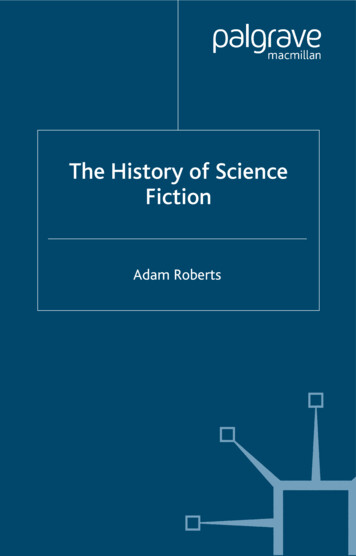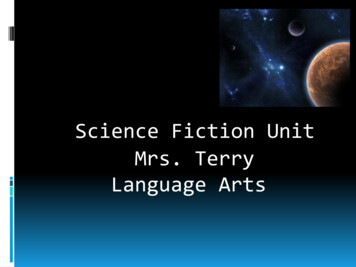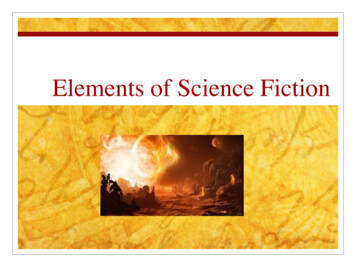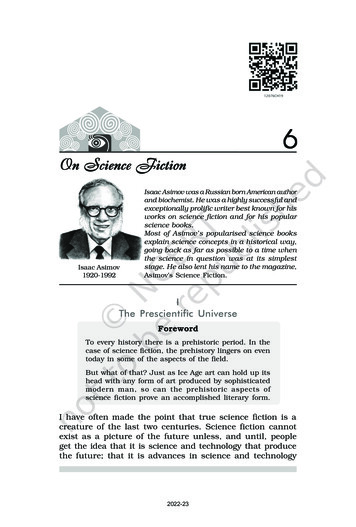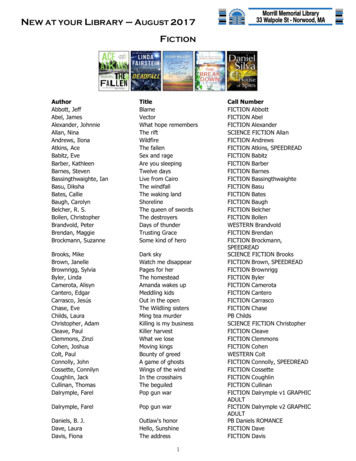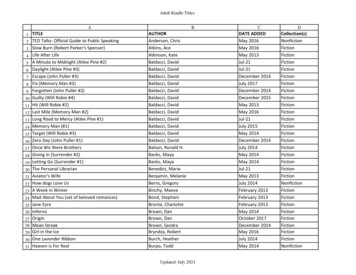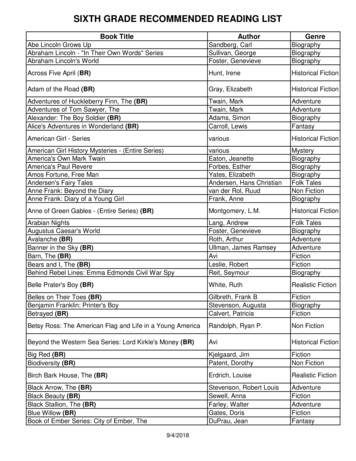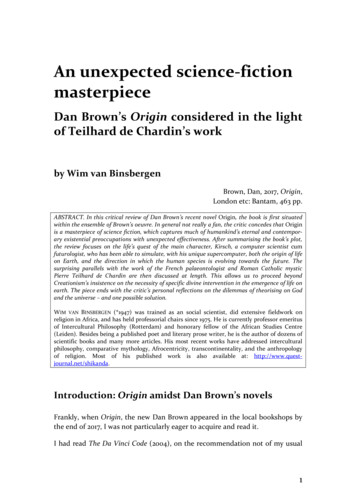
Transcription
An unexpected science-fictionmasterpieceDan Brown’s Origin considered in the lightof Teilhard de Chardin’s workby Wim van BinsbergenBrown, Dan, 2017, Origin,London etc: Bantam, 463 pp.ABSTRACT. In this critical review of Dan Brown’s recent novel Origin, the book is first situatedwithin the ensemble of Brown’s oeuvre. In general not really a fan, the critic concedes that Originis a masterpiece of science fiction, which captures much of humankind’s eternal and contemporary existential preoccupations with unexpected effectiveness. After summarising the book’s plot,the review focuses on the life’s quest of the main character, Kirsch, a computer scientist cumfuturologist, who has been able to simulate, with his unique supercomputer, both the origin of lifeon Earth, and the direction in which the human species is evolving towards the future. Thesurprising parallels with the work of the French palaeontologist and Roman Catholic mysticPierre Teilhard de Chardin are then discussed at length. This allows us to proceed beyondCreationism’s insistence on the necessity of specific divine intervention in the emergence of life onearth. The piece ends with the critic’s personal reflections on the dilemmas of theorising on Godand the universe – and one possible solution.WIM VAN BINSBERGEN (*1947) was trained as an social scientist, did extensive fieldwork onreligion in Africa, and has held professorial chairs since 1975. He is currently professor emeritusof Intercultural Philosophy (Rotterdam) and honorary fellow of the African Studies Centre(Leiden). Besides being a published poet and literary prose writer, he is the author of dozens ofscientific books and many more articles. His most recent works have addressed interculturalphilosophy, comparative mythology, Afrocentricity, transcontinentality, and the anthropologyof religion. Most of his published work is also available at: http://www.questjournal.net/shikanda.Introduction: Origin amidst Dan Brown’s novelsFrankly, when Origin, the new Dan Brown appeared in the local bookshops bythe end of 2017, I was not particularly eager to acquire and read it.I had read The Da Vinci Code (2004), on the recommendation not of my usual1
literary advisors but of that of my athletic eldest son, whose informal father-inlaw (a professor of psychology and, like me, a poet) had greatly enjoyed thebook. The mixture of Christian historical myth (the ‘bloodline’ of the founder ofChristianity had been the subject of several other speculative bestsellers in theprevious decade), Early Modern science, Swiss bank secrets, British nobility,secret societies and terrorist murder, full of rapid plot changes and cliffhangers, had been entertaining to the very end: the eerie, dreamy evocation ofthe Scottish chapple where Christ’s last surviving alleged descendants were reunited as one little happy family – fully aware of their divine global mission,and amply compensated for the sacrilegious Black Mass the book’s heroine as achild had seen her grandfather perform, when she was peeping in through theircastle’s window. Nonetheless, donning his Mickey-Mouse wristwatch,emulating vague popular stereotypes of the Harvard professor (Brown’srendering on this point remains totally unconvincing to me, who from 2004 to2010 was a very regular participant in Harvard intellectual exchanges) and ofthe non-existing field of ‘symbolology’, the book’s male protagonist RobertLangdon did not come to life – his psychology was if possible even flatter thanthat of his female counterpart, even more reminiscent of early science fictionfull of clichéd scholarly and academic couleur locale, his lapses intocolloquialisms too un-professorial, his Harvard too much a view from afar. Isuppose it was only in order to stress this fake dimension of the book that inthe movie, Langdon was played by the gregarious and blatantly non-academicTom Hanks, while the heroine was brought to a comic, equally unsophisticatedand miscast life by the French comic actress Audrey Tautou.I soon read other ‘Dan Brown’s. Some showed amazing skill and accomplishments (I particularly liked the first, Angels and Demons, which afforded my wifeand me a welcome travel guide for a fascinating afternoon in Rome when wehad no more time to spare, and which rekindled my altar boy’s childhoodexperiences mixed with fantasy, of Roman Catholic clerics as a vain, murderous,lascivious, heretical lot – but how on earth could a future pope resign himself tothe idea that impregnating a nun through Artificial Insemination was noinfringement of his, nor her, vow of chastity?). Most titles in this series,however, in my opinion revolved on an appalling display of flimsily appropriated Internet gleanings passed off as state-of-the-art architectural, historicaland art-historical knowledge. For me The Lost Symbol was the last straw: afantasy on Freemasonry symbolism in USA state architecture at WashingtonDC – how could a prodigal son who left home as a near-adult, after many yearsin which he cherished his childhood resentments re-enter the life of his richand powerful father and not be recognised? However, also these later bookshad proved entertaining reads, if intellectually and literarily shallow; and being2
involved in a protracted and exhausting process of moving house I expected atleast entertainment from Origin, – miles away from the philosophical,scientific, comparative-mythological and belles-lettres canon with which Inormally occupy myself as an intellectual producer.However, much to my regret I have no option but to report the following. Afterthe predictably slow and somewhat clumsy first fifty pages, O r i g i n i s a namazingly well-written exploration of some of themost profound and enduring preoccupations of thehuman mind, and specifically of our globalised,d i g i t a l i s e d w o r l d t o d a y . The book aptly (though somewhatamazingly) avoids the most conspicuous international conflict matter of today(the North Atlantic demonisation of Islam, and the Islamic demonisation of theNorth Atlantic region). Instead, it addresses far more essential and enduringproblematics: the origin of life on Earth, the future of humankind, the debateon the relation between religion and science, and the excesses of recentCreationism as a theology of the long-term history of the universe and of life onEarth. For a change, Brown’s input of scientific knowledge, although inevitablysecond-hand (after all, he is a failed pop musician and a best-selling author, nota scientist), is far from stale, but, on the contrary, up-to-date, complex, andbrilliantly managed. An extensive team of editors and copy editors has ensuredthat most of the prose is of exceptional quality, and that unmistakable slips ofthe pen are very rare. Used, by now, to the jaded amateurism and antiintellectualism of pseudo-professor Langdon I was not so irritated any more bythe details (like Langdon, I am myself a prominent comparative mythologist),and, I must admit, I was increasingly captivated by the author’s serious andrelevant voice unfolding state-of-the-art versions of perennial central questionsof humankind.Where do we come from – Who are we? – Where are wegoing?’In 2010, when, at Harvard, Eric Venbrux and I presented our edited proceedingsof the Second Annual Conference of the International Association ofComparative Mythology which we had organised, the doyen of that field, theSanskritist Michael Witzel, concluded his presidential address with aPowerPoint slide showing Gauguin’s well-known monumental painting entitled‘D'ou venons-nous – Que sommes-nous – Où allons-nous’. These very words arewritten in a corner of the painting, and Witzel (German-born, and ever since3
his transfer from Leiden a true Harvard professor) generously (but, as I pointedout in the subsequent debate, somewhat shallowly, from a philosophical pointof view) claimed that the painter had phrased there the three central questionsof all human thought and all mythology: Where do we come from – Who arewe? – Where are we going?’I could not help wondering if perhaps more of Witzel had gone into Originthan Brown gave him credit for – Witzel is totally absent from the long list ofacknowledgements that conclude the book. Anyway, Gauguin’s title runs as ared thread through Origin, and determines much of its structure.Fig. 1. Gauguin’s painting ‘D'ou venons-nous – Que sommes-nous – Où allons-nous’.Origin is full of felicitous trouvailles which show what mastery Brown hasacquired by now, in his early fifties. The book not only uses extensive data fromthe Internet, but also is a incessant celebration, in form and content (wholesections emulate web pages!), to Internet as it has established itself as thestandard mode of expression and of interaction in the course of the last decade.The novel’s characters communicate not by postal pigeons or smoke columns,not even by secret letters smuggled in by a trusted servant, and only rarely bytelepathy, but like we all do these days, by Internet / e-mail / text messages /Whatsapp. This renders an immense credibility and unity of style and purposeto the book – even though the same approach, in the hands of a lesser writer(and of lesser editors, I suppose.) would have produced a boring and merelyfashionable but essentially ephemeral text.This permanent emphasis on recent media also constitutes a constant hommage to the4
character who, more even than Langdon and his reluctant heroine (the female museumdirector Ambra Vidal, ‘the future Queen of Spain’) is the true protagonist of this book,notably the computer scientist, futurologist, modern oracle and multi-billionaireEdmond Kirsch. The Spanish crown prince’s fiancée remains bleak, featureless, stilted,devoid of personality, like all of Dan Brown’s heroines and in fact like Langdon himselfalso in this book. By contrast, Kirsch is truly ‘A Hero of Our Time’ (Lermontov). His ragsto-riches story (like in Angels and Demons again the nun who gives birth – in this case,for once, using the usual procreative anatomy, and fortunately before making her vows)does manifest some of the thin, early-science-fiction psychology Brown is addicted to (iteffectively spoiled The Lost Symbol, and almost spoiled Angels and Demons). Yet as atop-ranking specialist in Artificial Intelligence, and as a more than passionate andabundantly equipped thinker struggling to find the ultimate answers to Gauguin’squestions, Kirsch is in an excellent – and what is more, credible – position to invent,build and finance the supercomputer with which these questions may now be answeredwith state-of-the-art techniques of mathematical modelling and simulation. Thisrequires unprecedented calculating power which before the quantum computer wassimply unimaginable, but which now enables Kirsch to replicate the famous 1952-1959Miller-Urey experiments in which the conditions of the Earth’s presumed primordialatmosphere were modelled in a few test tubes for a few weeks.Simulating the origin of life on EarthFig. 2. Schematic view of Miller’s 1952 experiment (Miller 1953: 528).11Although meanwhile raised to iconic status, the Miller-Urey findings have not gone withoutprofound criticism; cf. the opening chapter in Wells 2002, where he speaks of misleading andmythology. In other chapters he criticises the idea of the Tree of Life (popular with Darwin and many ofhis sympathisers, including Teilhard de Chardin, cf. Teilhard 1955: 86; for a general overview of trees oflife, cf. Pietsch 2012). Meanwhile the simple, one-origin tree model has been increasingly criticised as5
What made those experiments audacious and thrilling is that less than acentury earlier test tubes had been used (Huxley 1873: 218 f.) to demonstrate thevery opposite: that life could not possibly emerge from dead matter, in otherwords, that the generatio spontanea in which many generations of earlyscientists had believed, was an impossibility. Two-thirds of a century ago,Miller’s and Urey’s experiments certainly did not yield life, but at least some ofits indispensable building bricks – amino acids. (Brown, who obviously andunderstandably is only familiar with these experiments as mediated by today’ssecondary reports, believes that these results were considered negative at thetime, as if the experiments were failures; but I learned about them – and aboutOparin’s 1938 / 1953 counterpart experiments in the Soviet Union, mentioned inMiller’s first, 1953 publication2 – as a boy, in the wake of the centenary ofDarwin’s (1859) Origin of Species, and then scientific opinion was far morepositive, not to say elated; cf Quispel 1960). Kirsch’s supercomputer allows himto engage in digital simulation on an even grander scale than is already habitualin this field of advanced and boundary-crossing research. He thus manages toconvert the simulation model into an incredibly precise and comprehensivetime machine, re-calculate the probable fate of every atom and molecule, yeaevery electron, electromagnetic discharge, and gamma ray in these test tubes,not just for a few weeks but for millions of years forward and backward, andthus to recapture the most probable details of the origin of life on Earth.This yields Kirsch the answer to one of his momentous questions – but ithappens to be the very same answer (and this is one of the few regrettableoversights of Brown’s book) which also the controversial science-and-religionwriter of a much earlier vintage, the French geologist / palaeontologist PierreTeilhard de Chardin, gave in Le Phenomène Humain (1955, originally written1940):3 life can emerge from matter on the basis of no other conditions thanmerely a simplistic, linearised model of thought hailing from the Romantic period (cf. Bernal 1990: 2 f.,53 f.; Blazek 2007; Kammerzell 1994, Salminen 2002; Dewar 1995).2There is an interesting link here with another long-standing interest of mine (van Binsbergen2011): the Black-Athena debate, as initiated by Martin Gardiner Bernal (Bernal 1987-2006). Hisfather, John Desmond Bernal, a leading physico-chemist widely known for his four-volumesocial history of science, was with J.B.S. Haldane one of the pioneers in the West of a naturalscience approach to the origin of life (cf. Bernal et al. 1962 / 1957) , and both were staunchMoscow communists. Finding a materialist explanation for the origin of life was for them aninteresting application of the historical materialism of Marx, Engels and Lenin. Martin,although himself not really a communist, originally studied Sinology in Cambridge UK (wherefor some time he lived in the house of the leading anthropologist Meyer Fortes), and wrote aPhD on Chinese communism in the early 20th c. CE.3Ever since his death in 1955, when the Roman Catholic church lifted the embargo on thepublication of his writings, an enormous literature has grown around Teilhard’s work andperson. The principal works are easily identified on and retrieved from the Internet, and I6
simply those contained in the natural laws that supposedly have unalteringlygoverned all so-called dead matter since, supposedly, the beginning of time. Forthe emergence of life on Earth there is no need whatsoever to invoke thespecific intercession of a personal, creative god.4 We will come back below tothe several reservations (‘supposedly.’) which the previous statement contains.Fig. 3. Cuénot’s 1951 ‘Tree of Life’ as copied in Teilhard de Chardin 1955: 86Debating the origin of life on EarthKirsch’s research is set against the background of a major ideological war nowbeing waged in American (i.e. USA) intellectual and religious life: that betweenshrink from listing them here.4This reiterates Immanuel Kant’s introduction to his theory on the origin of the Solar system(1755): if we can explain phenomena by an appeal to natural laws, which are divine creationsanyway and splendidly testify to God’s glory, why take recourse to the idea of direct divineintervention?7
scientism5 and creationism (cf. Scott 2004; Sweetman 2015; National Academyof Sciences 2008; Ruse 2008). The latter position, vocally and fanatically voicedby many devout Christians, holds that the creation of life out of dead matter inEarth’s early history, a few billion years ago, necessarily required theintercession of a personal creator god. Kirsch’s outcome seems to amount tothe ultimate refutation of creationism. This is why his results are deemed to beso worrying to the world’s religious leaders – three of whom (a top-rankingJewish Rabbi, a Roman Catholic bishop, and a prominent Muslim scholar) hehas given a preview of his findings a few weeks before divulging them throughdigital media on a global scale. Convinced that Kirsch’s findings will dodevastating damage to existing religious beliefs concerning creation, thesereligious leaders ask him to postpone the public presentation, and soonafterwards two of them are murdered as a result of what looks like a globalconspiracy against Kirsch. When Kirsch finally goes public with his findingsand stages a major media events for this purpose, he himself is shot down by aSpanish retired admiral belonging to an obscure Christian sect. This happenshalfway Kirsch’s initial presentation, before the essence of his findings has evenbeen disclosed. Langdon and Ambra Vidal witness the murder at close quarters,and go on a wild chase (with extensive parallels in earlier Brown books, alwaysalong the world’s major architectural and sculptural sites – this time AntonioGaudi’s Sacrada Familia cathedral in Barcelona) in order to procure thepassword that can unlock the essential part of Kirsch’s intended presentationfrom his supercomputer and thus divulge his findings even after his death. Inthe process – which ultimately proves successful – they are greatly assisted by apersonalised sub-programme in Kirsch’s supercomputer, ‘Winston’, completewith British name and accent, who keeps feeding them with information,backgrounds, internet searches etc. In the end however it perspires that‘Winston’ himself is responsible for the conspiracy against the world-religionleaders, and even for the murderous plot against Kirsch himself – not out of amachine version of malice, but in a simple but eminently successful bid tomaximise the media attention and possible impact of his master’s presentation,who was already destined to die from pancreatic cancer a few days after thepresentation anyway.65Note my distinction between science (see my definition below) and scientism (i.e. theessentially fundamentalist and anti-scientific mis-appropriation and reification of scientificideas and results as lastingly and universally true.6One of the ways in which science fiction has managed to create a veridical illusion ofrendering a real future life world is through intertextuality: the same concepts, such as warpspeed, hyperspace, co-existing multiple worlds branching off whenever a specific choice is madebetween alternatives, crop up in very different narratives written by very different authors, and8
‘Winston’ is at the same time a fascinating illustration of the heights ofachievement which Artificial Intelligence research has reached in the hands ofKirsch and the likes of him; a warning of the dangers which such technology(i.e. thought unmitigated by human values and ethics) may entail; and aprelude to the answer of the future-directed other main question posed byKirsch (and Gauguin): where are we going. On this point the time span becomesgreatly compressed: no longer several billions years between the origin of lifeon Earth, and the present – but only half a century between now, and the totalmutation of humanity. By the mid-21st century CE, as Kirsch’s supercomputersimulations bring out, the human species as we know it will be radicallychanged in that it will have been incorporated by, or supplanted by, now stillunpredictable forms of Artificial Intelligence, whose materiality will only bepartially carbon- and cell-based, and largely amount to further developments ofthe quantum computer technology now still in its infancy.7When Kirsch’s full message to the world is finally broadcast as a result of theheroic exploits of Langdon and Vidal’, and his vision of the past and future ofhumankind has been unfolded, it ends in an optimistic and inspiring eulogy ofscience. Rather than eclipsing all previous religion, this is claimed to constitutethe formulation of a new religion of science – not unlike the futuristic vision ofthe future of human knowledge as formulated by the French pioneer sociologistAugust Comte in the 1830s. The opposition between science and religion, didnot only dominate much of Early Modern European intellectual developments(with Galilei as an exemplary case), but also, half a millennium earlier, led tothe eclipse of science and philosophy in medieval Islam. And after recentlyprecipitating the science wars of the North Atlantic region around the year2000 CE, this opposition finally turns out – at least within Origin – to be falseand unnecessary: science can only have its beneficial impact on human societyonce it becomes religion in its own right. Kirsch, rather than being thethis produces the converging illusion of a truth rendering of an existing reality. The prominentscience-fiction writer and natural-science professor Isaac Asimov has greatly contributed to thiscommon pool, for instance by formulating ‘the three laws of robotics’ – the principal of which isthat a robot cannot turn against its master. In Origin, ‘Winston’ certainly does just that.Langdon, when realising that this is the case, explicitly declares that a programming line ‘youshall not kill’ should have been added to ‘Winston’’s software – but the immense implicationsagainst the background of converging science-fiction worlds (where, intertextually, all robotsare invariably built to comply with the three laws of robotics) seem to escape Brown.7Here Brown is taking up an idea that has been circulating in the world of Artificial Intelligenceand its philosophy for at least two decades: the replacement of the human natural brain bycomputer hard discs, so that minds will be downloaded there and humanity will finally be ableto shed its allegedly embarassing and imprisoning ‘carbon chauvinism’ – as Jos de Mul used toput it, one of my Rotterdam philosophical colleagues in the 1990s-2000s.9
destroyer of all religion, thus, quite deliberately, finds his true calling bybecoming a new religious prophet in his own right.While Brown’s adventurous novel Origin is entertaining, convincing, andmoving, right to the very end, the main point I wish to make here is not somuch to stress its unexpected literary and visionary quality, and its closeness tocontemporary scientific and ideological research and debate. Admittedly, theseare considerable achievements, but my personal fascination with this book lieselsewhere: as food for thought about cosmology, about humans and their placein the universe, and about the existence and nature of God.Enters Teilhard de ChardinFig. 4. Pierre Teilhard de Chardin S.J. (1881-1955) in 1947 – the present author’s year ofbirth (source: Archives des Jésuites de France).I have taken a great personal interest in some of the underlying themes forwell over half a century: evolution, the origin of life on Earth, Man’s placein Nature and in the Universe, the religious implications of any scientificfindings bearing on these topics. As an adolescent I was already conversantwith the life’s work of Teilhard the Chardin then being published in Frenchafter its author’s death in 1955. Teilhard is nowhere mentioned or evenhinted at in Origin, and I am confident that Brown has not been directlyinfluenced by the French thinker, whose struggle for the complementarity10
of science and religion rocked the Roman Catholic intelligentsia andleadership in the mid-20th century, and some of whose ideas havegradually been adopted in diffuse, attenuated and implicit form in modernintellectual life in general. If Brown had been more specifically aware ofTeilhard’s work, he would have keenly realised that Kirsch with hissimulation of the origin of life was only providing a partial answer, and thatrecent Creationism is largely barking up the wrong tree. Also in athoroughly theistic world-view, as Teilhard’s, life can emerge from naturalcauses without requiring direct divine intervention.In a nutshell, Teilhard de Chardin’s vision of the history of the universe isas follows. The emergence of life and that of thought in the history of theEarth, and of the universe, present obvious difficulties if life and thoughtare considered – as has been usual throughout the history of Westernthought since Antiquity – to be phenomena totally alien to lifeless matter.Teilhard’s ingenious solution is the following:8 Spirit is not an epiphenomenon of relatively late appearance in the evolution of the universe, but auniversal and perennial quality. Not just since the origin of life, butthroughout the existence of the universe, matter has always had twoaspects – a material, apparently lifeless, outside, and a potentially spiritualinside. The evolution proceeds from simple to more complex materialforms, and the more complex a material form, the more conspicuously andarticulatedly the spiritual inside may manifest itself. With increasingcomplexity, a threshold value was crossed and life emerged, several billionyears ago. With increasing complexity of life forms and especially of thebrain, human self-reflexive thought emerged, by today’s specialists’consensus a few million years ago (Largely because of the lack of essentialdata meanwhile provided especially by African material, Teilhard’s timescale for humanity was still more compressed and remained well under onemillion years). Throughout the Palaeolithic, Mesolithic and Neolithicperiods the consistent progress persisted towards complexity and theunfolding of spirit; despite Teilhard’s biological, evolutionary language andhis lack of a professional philosophical frame of reference, there is agenuine parallel with Hegel here.After the geological phase of the lithosphere (‘stone spherical layer’), and after lifeforms had enwrapped the Earth in a biosphere (‘life spherical layer’), Teilhard sees8I cannot go here into the antecedents of Teilhard’s solution. His ideas come close to theconcept of ‘subtle matter’, whose world history of ideas has been painstakingly traced byPoortman 1978. ‘Emergence’ is a concept frequently resorted to in theories of evolution.11
the emergence of humans lead to a new layer, that of the noosphere – the‘consciousness spherical layer. This geological imagery brings him, regrettably, toalmost totally ignore the dazzling specific forms of social and cultural evolution andtheir proliferation on the various continents of the world since the Palaeolithic.Remarkably out of touch with significant developments in 20th-c. CE archaeology(which yet shades over into palaeoanthropology, one of Teilhard’s specialties),naïvety and ignorance in the face of social and cultural phenomena is a majorshortcoming of Teilhard’s work. Toulmin could even reproach him for having livedin China for twenty years and yet remaining devoid of the slightest knowledge andappreciation of Chinese language, culture and history. However, Teilhard did workclosely together with Chinese colleagues, and published with them (Black et al. 1933;Teilhard & Yang 1929).Fig. 4. Figure schématique symbolisant le développement de la Nappe humaine. Les chiffres àgauche comptent les milliers d'années. Ils représentent un minimum, et devraient sans douteêtre au moins doublés. La zone hypothétique de convergence sur Oméga (en pointillé) n'estévidemment pas exprimée à l'échelle. Par analogie avec les autres Nappes vivantes, sa duréeserait de l'ordre des millions d'années.Fig. 5. The evolution of humanity according to Teilhard de Chardin: towards the Point Omega (Teilhard1955: 212).12
Fig. 6. Teilhard de Chardin’s vision of cosmic coherence through progressive complexity, all theway to the Point Omega (from Teilhard 1956).And, like Brown’s protagonist Kirsch in the 2010s, Teilhard also believed hecould make out the direction of human evolution. He sees the entireuniverse as involved in one all-encompassing progress towards ultimatecomplexity and ultimate spirit – a so-called ‘Point Omega’9 to be reached inthe distant future (a few million years?) when, through an evolved andunified humanity, the universe, which has become self-reflexive throughMan as its most advanced product,10 will reach its consummate develop-9The omega is the final letter of the Greek alphabet, and in Christian theology Christ is knownas the Alpha and Omega – the beginning and the end (cf. Revelation 1:8). Theologically,Teilhard’s Point Omega merges with the established Christian concept of the Second Coming ofChrist, and this has been a major point of criticism which Christian orthodoxy has levelledagainst Teilhard.10Here both Brown / Kirsch and Teilhard fall victim to the same antiquated geocentrism(‘earth-centredness’) – as if humankind, and the Earth that produced it, constitute the selfevident unique centre and end point of the universe. Science fiction was thriving, but actualspace travel was still non-existent when Teilhard wrote his principal works; the first unmannedartificial satellite was launched from Earth by the USSR two years after his death. Since, thediscovery of hundreds of planets outside our Solar system, and the study of possible conditionsfor life outside the Earth (e.g. Seckbach 2004), have made us suspicious of such terrestrialchauvinism. However, if science fiction can realistically evoke the vision of extraterrestrialtravel and socio-political organisation (Asimov’s immensely successful Foundation series is acase in point), it would be relatively easy to rewrite Teilhard’s vision of the future in thisdirection. In fact, Teilhard himself foresaw these developments, and addressed them in a 1953piece w
Dan Brown's Origin considered in the light of Teilhard de Chardin's work by Wim van Binsbergen Brown, Dan, 2017, Origin, London etc: Bantam, 463 pp. ABSTRACT. In this critical review of Dan Brown's recent novel Origin, the book is first situated within the ensemble of Brown's oeuvre.
